Our view at Stack - Simplify growth with an all-in-one platform. Powerful marketing, sales, and support automation. Integrated CMS. Scalable software. Crafted for customer experience.
Meghan Keaney Anderson has centered her career around content creation. So, when pivoting her career into the world of generative AI, which could supposedly
replace writers, she received one resounding question from peers: Why?
![Download Now: The Annual State of Artificial Intelligence in 2024 [Free Report]](https://no-cache.hubspot.com/cta/default/53/b72f2b25-8cc9-4642-9a1b-1e675d3d273b.png)
Her answer? “[Generative AI] is here, and we need to steer it in the right direction to reach its potential. I hope that we as creators and marketers and business leaders will take the reins of this technology and bend the arc of its use towards something positive.”
This series explores some of the strongest opportunities for AI in the marketing world today and in the near future, backed by HubSpot original research from our State of AI Survey, and expert perspectives from major brands including Jasper, ZoomInfo, and Mention.com.
Top Generative AI Marketing Findings for 2024 [New Data]
1. 85% of marketers believe generative AI will transform content creation in 2024.
It’s clear that AI is poised to revolutionize the marketing industry. But how is a different story.
So we asked marketers: In which aspects of your role do you already leverage AI?
For starters, a staggering 81% of marketers leveraging generative AI report it enhances their roles.
Here’s how generative AI helps marketers with their roles:

Image Source
As a blogger, one of the primary use cases for AI that I‘ve heard about has been blog creation. However, it’s not the only use case — or even necessarily the most effective one.
So far, 56% of marketers who use generative AI for content creation say it performs better than content created without it.
Creating AI tools themselves is also an incredibly effective lead-generation strategy.
As Amilah Ali, Mention’s Content Marketing Manager, told me, “Creating free AI tools has helped our brand with both brand awareness and lead generation, as individuals who use these tools are more likely to remember the Mention brand, and may also become potential customers in the future.”
If you don’t have the time or resources to create your own branded AI tools, there are plenty that can help you deliver more value in your work.
For instance, Mention, a social media listening and monitoring tool, used OpenAI’s GPT-3 capabilities to create an Instagram Caption Generator and Instagram Hashtag Generator. They’ve also created AI tools that help users generate social media bios across popular platforms like Instagram, X, and TikTok.
Helpful Content
- AI in Content Creation: How Creators and Marketers are Using It [Data]
- How to Fit AI Into Your Content Marketing Strategy [+ Its Biggest Pitfalls], According to Jasper’s Head of Enterprise Marketing
- AI Images in Marketing: What to Consider Before Leveraging Them
2. 77% of marketers report that generative AI helps create more personalized content.
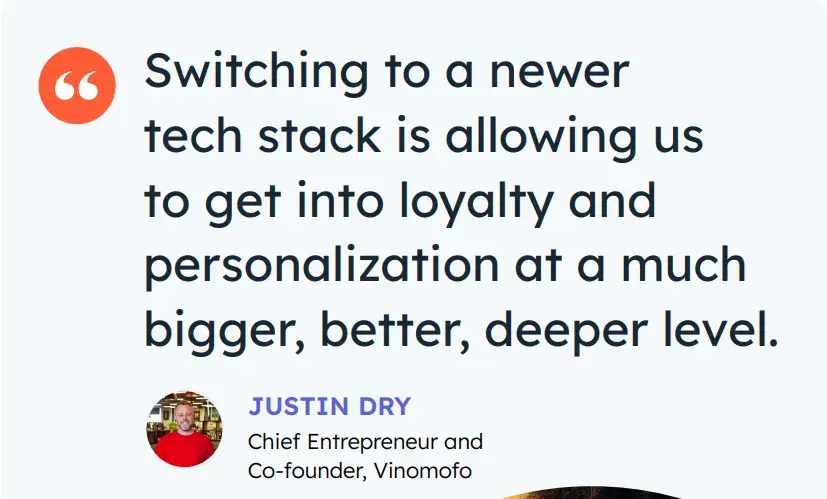
Image Source
As a writer, I was hesitant to believe that a robot could do my job better than I could.
And, in truth, it can’t do my job alone. But it can greatly supercharge my own productivity and even upscale my content.
In fact, 77% of marketers believe generative AI marketing is effective at making their content more personalized, 96% say personalization increases buyer repeat purchases, and 94% believe it boosts sales.
(215% more marketers will likely consider their marketing strategy effective if it offers a personalized experience.)
This makes sense: Generative AI is a powerful tool for generating strong ideas, brainstorming more unique angles for your content, and researching topics more in-depth than you otherwise could.
As Samyutha Reddy, Jasper’s Head of Enterprise Marketing, told me recently, “AI augments the human experience, but it doesn’t replace the human within that experience. We value writers in our society because they’re able to give us a thought-provoking human perspective on the world.”
She adds, “It isn’t just about summarizing facts that are out there. It’s about humans sharing opinions on very real topics that help build your perspective on how you feel about something. So an AI could really never replace that human perspective.”
Helpful Content
- Your Guide to the Best AI SEO Tools in 2024 [Free and Paid]
- Why AI Isn’t Replacing Our Jobs — Or Search Engines — According to Jasper’s Head of Enterprise Marketing
3. Generative AI saves marketers 3 hours on a single piece of content and 2.5 hours per day.
One of the most important benefits of generative AI marketing is how much time it can save for your team.
On average, marketers told us they save three hours per piece of content and two and a half hours per day.
Wow. Let that sink in.
For a writer who needs to complete four posts a week, that translates to over 12 hours — more than a full workday! — that you can now spend up-leveling your career, seeking out more interesting angles for your topics, or focusing on other aspects of your role.
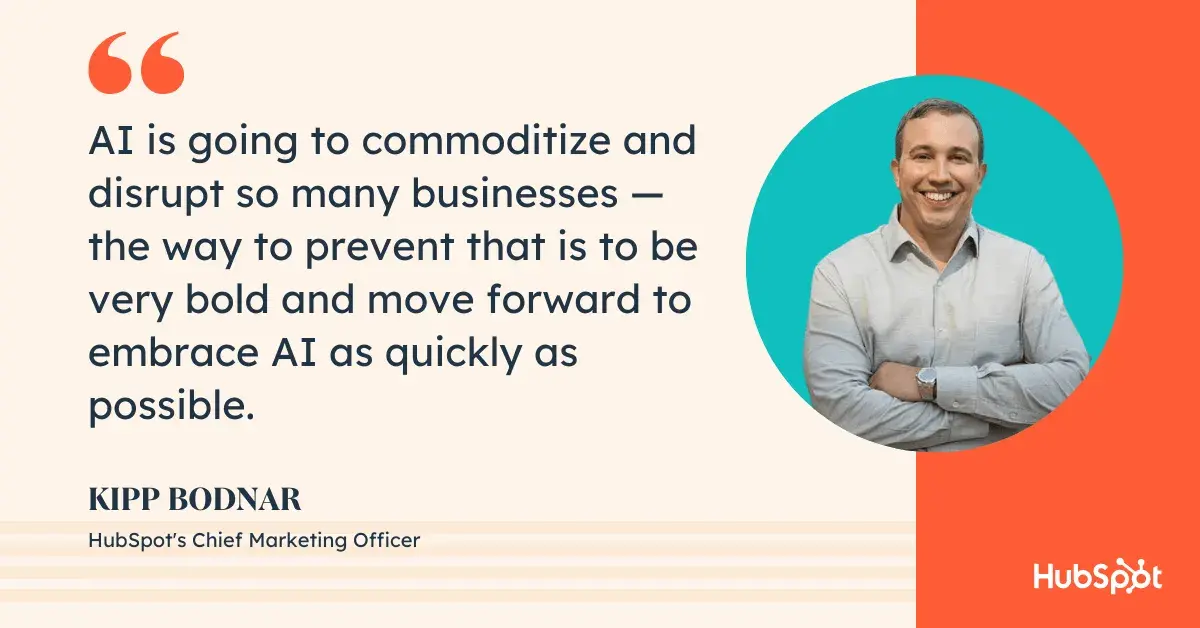
Image Source
As HubSpot’s CMO Kipp Bodnar puts it, “[AI] gives you the time to obsess over your customers again.”
He goes on to provide a few examples: “It gives your sales team time to genuinely connect with customers and work with them to identify how your products can solve for their unique needs.
It gives your support team the ability to focus on complex customer challenges rather than being bogged down by tickets that could be answered by a chatbot.”
He adds, “It also gives your leaders the insights they need to make more high-impact, powerful decisions that align with what matters most to your customers.”
Helpful Content
- How AI Will Revolutionize the Future of Business, According to HubSpot’s CMO
- 10 Affordable AI Tools for Businesses (+ How to Implement Affordable AI)
4. Marketers who don’t use AI are worried about over-reliance.
While generative AI marketing offers many benefits, some companies still don‘t plan to use it just yet. Let’s dig into the top reasons why.
The number one: 43% of marketers who don‘t use AI are worried they’ll become overly reliant on AI tools.
HubSpot’s Senior Director of Content, Brad Wolverton, understands that marketers might feel an initial temptation to rely heavily on AI — but he believes that most marketers will quickly determine that AI alone doesn’t enable them to produce the type of high-quality content they need to stand out.
As Wolverton puts it, “The more reliant marketers become on AI to produce content, the less differentiated that content will feel, which will put a premium on higher-quality research and writing.”
He adds, “AI-generated sites will further erode the trust people have in what they hear and view online, creating opportunities for the companies willing to double down on creative talent.”
Other concerns? 60% of marketers using generative AI are concerned about potential harm to their brand’s reputation due to issues like bias, plagiarism, or misalignment with brand values.
Fortunately, these concerns don‘t mean you need to forgo leveraging AI entirely — they’re just valid reasons for practicing smart, responsible behaviors when you begin implementing AI at your company.
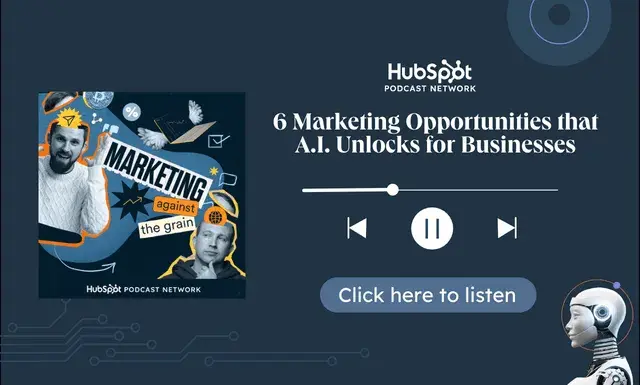
Image Source
A few tips:
- Be transparent with your audiences when you’re using AI. Let them know, “This blog post was written with the help of ChatGPT.” Whenever possible, being honest with your customers helps foster a sense of trust and could also provide helpful context for areas your customers could use AI. What I like: This transparency builds trust.
- Don’t consider AI as a human replacement. AI is meant to replace menial, tedious tasks like data collection, reporting, and research — but it shouldn’t steer the ship. As a writer, for instance, you still want to check the facts behind each article generated by AI. You should also edit the output to match your own tone, voice, and perspective. Best for: Content quality control.
- Start small. AI can feel daunting and overwhelming, so identify a few tasks on your team that could potentially benefit from AI and test out a few tools specifically designed to help you complete those tasks before thinking bigger. Pro tip: Start with lower-risk pilots.
It’s equally helpful to look at how other businesses use AI and take inspiration from them.
Helpful Content
- How Far Are We from AI Singularity? What It Means & Implications
- How Marketers Can Use AI Assistants [+12 Best Tools]
5. 55% of businesses predict that by 2024, most people will turn to chatbots over search engines for answers.
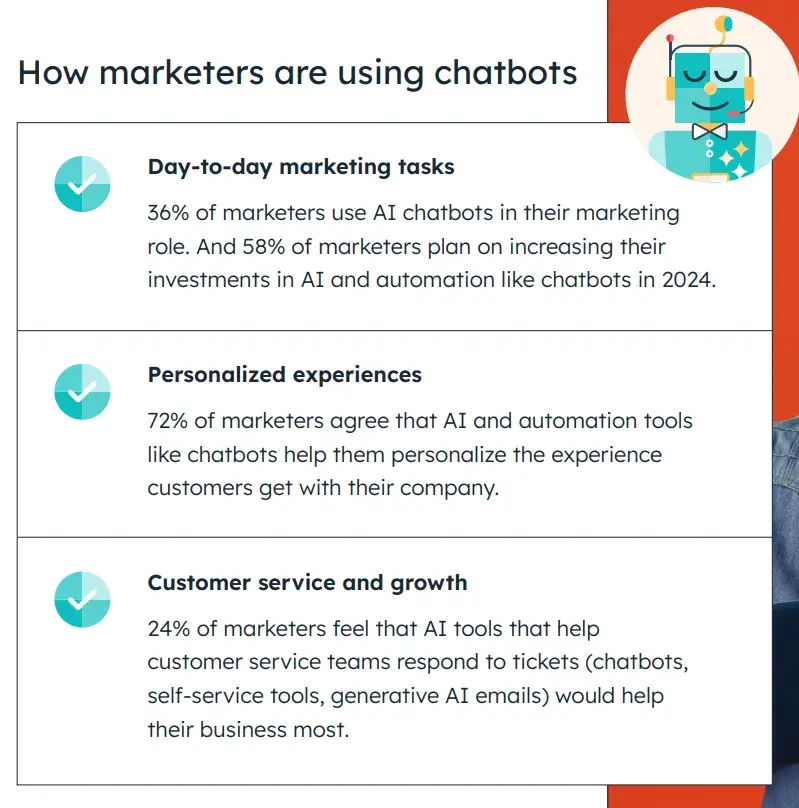
Image Source
You’re probably thinking — Okay, okay, I get it. AI is great. But what types of tools specifically should I be using in my role as a marketer?
For starters, the clear winner here is AI-powered chatbots. In our survey, 72% of marketers agreed that AI and automation tools like chatbots help them personalize the experience customers get with their company.
Beyond that, chatbots, including ChatGPT, Bing AI, and Google Bard, are rated the most effective for creating marketing content.
Prefer to make your own? Check out HubSpot’s Free Chatbot Builder, which enables you to create chatbot sequences without any coding and personalize chat replies with contact data pulled from HubSpot’s CRM.
Besides chatbots, marketers said other commonly used AI tools include visual AI tools (57%) and text generation tools (56%).
Unsure which tools are right for you? Take a look at 21 of the Best AI Chatbots for 2024.
One other quick note: If you plan to leverage chatbots to create content, transparency will be key.
As Litmus’ Content Marketing Manager Kimberly Huang puts it, “Rule of thumb: transparency is key. Dentsu found that over 70% of survey respondents want brands to disclose when they use AI across products, services, experiences, and content.”
She adds, “It may feel counterintuitive to do this, but being transparent with your audience ultimately leads to building trust. Especially as we move toward a more AI-integrated world, brands should lean into being open and honest with how they’re using AI.”
So — how can you do that?
Pringle suggests, “It’s as simple as adding in a line of copy that lets your audience know you used AI. For example, in a recent issue of our newsletter, Litmus Weekly, we used generative AI to help create content ideas. We ended the email by sharing ‘this email was written using Jasper.’”

Image Source
Convinced generative AI is going to supercharge your own role? Keep reading to learn how to properly harness AI as your new superpower.
Helpful Content
- 4 Types of Artificial Intelligence & What Marketers Are Using Most (Research)
- AI Chatbots: Our Top 21 Picks for 2024
- What Marketers Need to Know About ChatGPT, Google‘s Bard, and Microsoft’s Bing Chatbot
- 190 ChatGPT Prompts Marketers Should Use
- Making the Most of ChatGPT [+10 Examples]
How Marketers Can Harness AI as Their Superpower
1. Become an AI prompt and AI editing superstar.
As you begin dipping your toes into the waters of generative AI, you’ll want to ensure you read up on best practices when prompting AI.
A few tips:
- Be clear, concise, and specific in your prompts.
- Request structured data, such as tables or lists, which helps the AI provide a more accurate response. Best for: High-quality AI output.
- Test out different types of prompts, such as open-ended questions.
- Test out different prompt lengths. Sometimes, shorter is better. Other times, more details are needed.
- Be careful when prompting to ensure you’re being safe with internal customer data. Pro tip: Have data protection policies.
- Use actionable words in your prompts, like “Write,” “Summarize,” or “Translate.”
- Be specific on how you want the AI tool to present its output to your prompt.
Take a look at the following examples of weak versus strong prompts:
Why is the first one weak? Well, imagine if you told a junior associate at your marketing firm the same thing.
I‘d imagine she’d look up at you and say, “Okay… But how long should the social media post be? Do you want me to use emojis? Which social platform are you going to post this on? And is there anything important from the introduction that you definitely want me to include?”
Treat your AI chatbot the same way you’d treat a junior associate. Provide specific, actionable prompting to get the most out of the tool.
And, if you‘re curious, here’s ChatSpot’s response:

Impressive, huh?
Similar to prompting, you’ll want to become adept at scoping out prompt responses and editing for consistency across your content, tone of voice, and always double-checking that the information is accurate.
As Ben Salzman, SVP, GTM Strategy & ZI Labs at ZoomInfo, which launched a GTM Playbook with AI tips for sales teams, puts it:
“In our sales AI prompts, we include a specific person that the communication would come from, along with details about the prospect who will receive the outreach, including title and company. We also add tone guidance and constraints around how the outreach should sound, and of course, the scenario of the play.”
He adds, “We found that the more information we gave, the more time we saved when it came to editing and iteration.”
Ultimately, AI won’t replace humans — but the humans who know how to properly leverage AI will replace the humans who don’t.
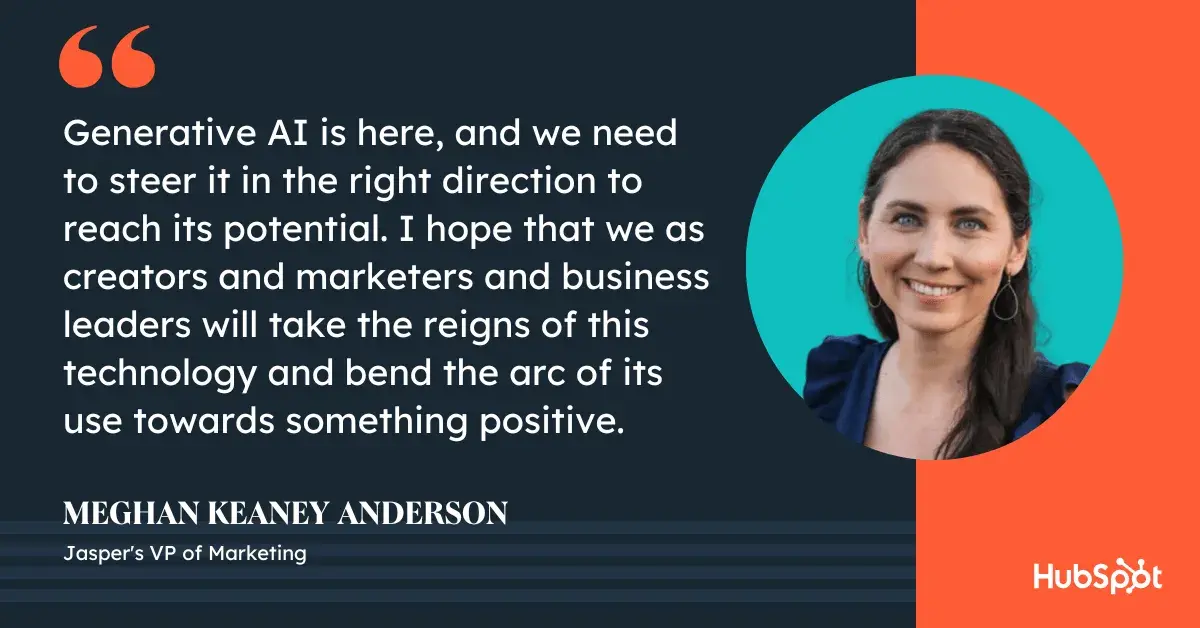
Image Source
2. Learn how to use AI to scale marketing campaigns.
It’s vital you take a multi-channel approach when creating content to attract prospects and engage with leads.
But that can be exhausting and time-intensive — which is where AI becomes your most beloved confidant.
As a marketer, you need to learn how to leverage AI to get more bang for your buck from one single piece of content.
For instance, let’s say you start with a blog post. You might use an AI-powered chatbot to create social media and email copy to distribute that content.
Additionally, you might convert the blog post into a video script so you can create an AI-powered YouTube video that revolves around the same topic. What I like: Content repurposing at scale.
You might even ask AI to help you turn that blog post into sales enablement materials.
AI can ultimately help you amplify your messaging across channels and distribution engines without requiring hours of coordination with other teams to create brand-new copy for various channels. Best for: Efficiency gains.
And that’s a huge win.
3. Prepare to re-evaluate your SEO strategy.
As more marketers — and consumers — begin leveraging chatbots to ask questions and seek out information rather than search engines, it stands to reason that the search landscape will change drastically.
To ensure your website is in the best position possible, it’s vital you re-evaluate your long-term SEO strategy.
Aja Frost, HubSpot’s Director of English Growth, told me, “SEOs have been fighting declining click-through rates from Google since the introduction of the first search features.
With the addition of AI-powered chat on the SERPs, it’s very possible Position 1 will become the only result that gets traffic. Bard shifts positions 2-10 below the fold. Depending on the length of the Bard-generated answer, even the first position might be!”
She advises, “In the short term, SEOs should evaluate which terms their websites are ranking for that are most likely to see Bard on the SERPs (likely ‘how’ and ‘why’ queries) and what percentage of their traffic that puts at risk.
The answers will help them develop a longer-term plan — investing in ranking for lower-risk queries, finding unique ways to enrich their content that AI can’t replicate, and more.”
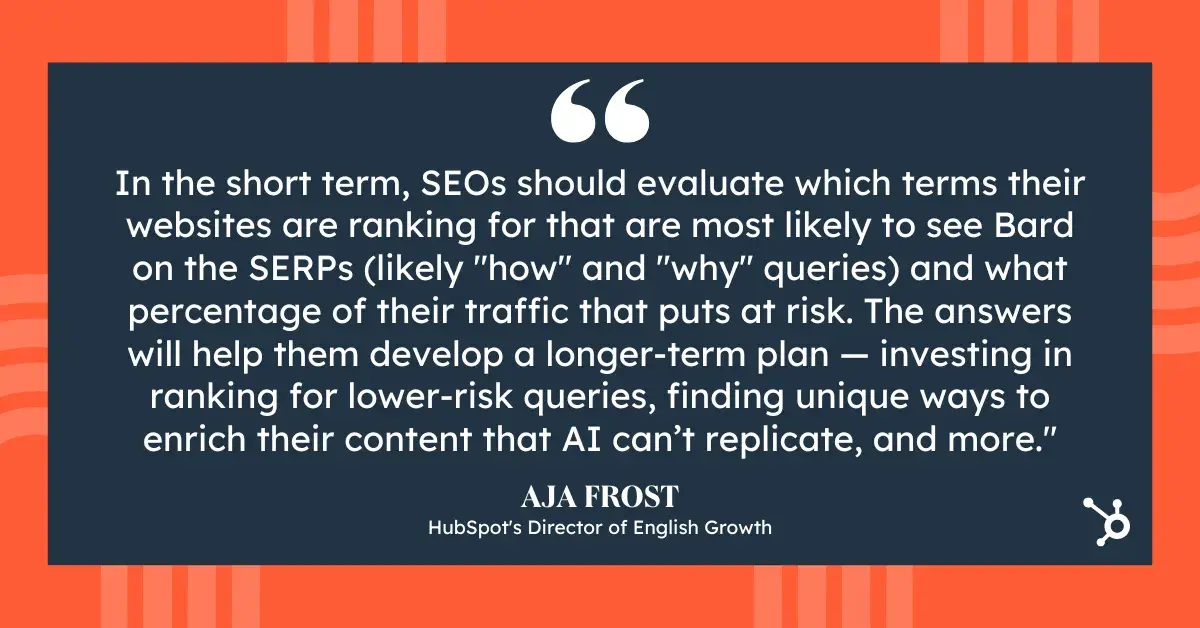
4. Become an explorer.
AI is still relatively new, and it can be scary to test out how you might leverage AI in your role. It might even be tempting to say, “I’ll just keep doing it the old way. Why fix what isn’t broken?”
But it’s equally risky to avoid AI, which will continue to change the way other marketers create, engage, and sell. You could be left behind if you don’t learn to leverage it for your own gain.
As HubSpot’s Bodnar puts it, “AI is going to commoditize and disrupt so many businesses that the way to prevent that is to be very bold and move forward to embrace AI as quickly as possible.”
Fortunately, this can become a fun aspect of your role. Start testing out new AI tools (a list of those can be found below).
Find out which tools are most effective for your team and share them widely across the organization. Become an explorer who is willing to slow down your current processes to test, iterate, and learn.
Trust me — in the long run, it’s worth it.
The Top AI Tools to Consider Leveraging Right Now
Here’s a quick and handy list of various AI tools suited for different needs.
|
AI Content Writing Tools |
AI Image Generation Tools |
AI Chatbots |
AI SEO Tools |
|
Content Assistant (in Beta) |
DALL-E 2 |
ChatSpot |
HubSpot AI Tools |
|
GetGenie |
Jasper Art |
HubSpot Chatbot Builder |
AlliAI |
|
Writesonic |
Dream by WOMBO |
ChatGPT |
Pro Rank Tracker |
|
Jasper |
Craiyon |
Bing Chat |
RankIQ |
|
Writer |
NightCafe |
Google’s Bard |
INK |
|
Rytr |
Midjourney |
Intercom |
Jasper |
|
Copy.ai |
Adobe Firefly |
Watson Assistant |
10Web |
Getting Started
Ultimately, the power of AI begins and ends with your own imagination: How generative AI fits into your marketing strategy and other business applications will depend on the creativity and vision of those leveraging these powerful tools.
In what ways can you imagine AI supercharging your work, now and in the future?
![]()
If Hubspot is of interest and you'd like more information, please do make contact or take a look in more detail here.
Credit: Original article published here.
